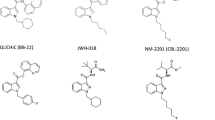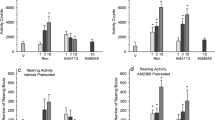Abstract
Rationale
Novel cannabinoid compounds continue to be marketed as “legal” marijuana substitutes, even though little is known about their molecular and behavioral effects.
Objectives
Six of these compounds (ADBICA, ADB-PINACA, THJ-2201, RCS-4, JWH-122, JWH-210) were tested for in vitro and in vivo cannabinoid-like effects to determine their abuse liability.
Methods
Binding to and functional activity at CB1 cannabinoid receptors was tested. Locomotor activity in mice was tested to screen for behavioral activity and to identify behaviorally active dose ranges and times of peak effect. Discriminative stimulus effects of the six compounds were tested in rats trained to discriminate Δ9-tetrahydrocannabinol (Δ9-THC).
Results
ADBICA, ADB-PINACA, THJ-2201, RCS-4, JWH-122, and JWH-210 showed high affinity binding at the CB1 receptor at nanomolar affinities (0.59 to 22.5 nM), and all acted as full agonists with nanomolar potencies (0.024 to 111 nM) when compared to the CB1 receptor full agonist CP 55940. All compounds depressed locomotor activity below 50 % of vehicle responding, with depressant effects lasting 1.5 to nearly 4 h. All compounds fully substituted (<80 % Δ9-THC-appropriate responding) for the discriminative stimulus effects of Δ9-THC. 3,4-Methylenedioxy-methamphetamine (MDMA) was tested as a negative control and did not substitute for Δ9-THC (11 % Δ9-THC-appropriate responding).
Conclusions
All six of the compounds acted at the CB1 receptor and produced behavioral effects common to abused cannabinoid compounds, which suggest that these compounds have substantial abuse liability common to controlled synthetic cannabinoid compounds.



Similar content being viewed by others
References
Atwood BK, Huffman J, Straiker A, Mackie K (2010) JWH018, a common constituent of ‘Spice’ herbal blends, is a potent and efficacious cannabinoid CB receptor agonist. Br J Pharmacol 160:585–593
Atwood BK, Lee D, Straiker A, Widlansk ITS, Mackie K (2011) CP47, 497-C8 and JWH073, commonly found in ‘Spice’ herbal blends, are potent and efficacious CB(1) cannabinoid receptor agonists. Eur J Pharmacol 659:139–145
Behonick G, Shanks KG, Firchau DJ, Mathur G, Lynch CF, Nashelsky M, Jaskierny DJ, Meroueh C (2014) Four postmortem case reports with quantitative detection of the synthetic cannabinoid, 5F-PB-22. J Anal Toxicol 38:559–562
Brents LK, Gallus-Zawada A, Radominska-Pandya A, Vasiljevik T, Prisinzano TE, Fantegrossi WE, Moran JH, Prather PL (2012) Monohydroxylated metabolites of the K2 synthetic cannabinoid JWH-073 retain intermediate to high cannabinoid 1 receptor (CB1R) affinity and exhibit neutral antagonist to partial agonist activity. Biochem Pharmacol 83:952–961
Buser GL, Gerona RR, Horowitz BZ, Vian KP, Troxell ML, Hendrickson RG, Houghton DC, Rozansky D, Su SW, Leman RF (2014) Acute kidney injury associated with smoking synthetic cannabinoid. Clin Toxicol (Phila) 52:664–673
Carvalho AF, Reyes BA, Ramalhosa F, Sousa N, Van Bockstaele EJ (2014) Repeated administration of a synthetic cannabinoid receptor agonist differentially affects cortical and accumbal neuronal morphology in adolescent and adult rats. Brain Struct Funct 2014 Oct 28
Castaneto MS, Scheidweiler KB, Gandhi A, Wohlfarth A, Klette KL, Martin TM, Huestis MA (2015) Quantitative urine confirmatory testing for synthetic cannabinoids in randomly collected urine specimens. Drug Test Anal 7:483–493
Centers for Disease Control and Prevention (2013) Acute kidney injury associated with synthetic cannabinoid use—multiple states, 2012. Morb Mortal Wkly Rep 62:93–98
Cha HJ, Lee KW, Song MJ, Hyeon YJ, Hwang JY, Jang CG, Ahn JI, Jeon SH, Kim HU, Kim YH, Seong WK, Kang H, Yoo HS, Jeong HS (2014) Dependence potential of the synthetic cannabinoids JWH-073, JWH-081, and JWH-210: in vivo and in vitro approaches. Biomol Ther (Seoul) 22:363–369
Chan WL, Wood DM, Hudson S, Dargan PI (2013) Acute psychosis associated with recreational use of benzofuran 6-(2-aminopropyl)benzofuran (6-APB) and cannabis. J Med Toxicol 9:278–281
Chaperon F, Soubrié P, Puech AJ, Thiébot MH (1998) Involvement of central cannabinoid (CB1) receptors in the establishment of place conditioning in rats. Psychopharmacology (Berl) 135:324–332
Cheer JF, Kendall DA, Marsden CA (2000) Cannabinoid receptors and reward in the rat: a conditioned place preference study. Psychopharmacology (Berl) 151:25–30
Drug Enforcement Administration, Department of Justice (2013) Establishment of drug codes for 26 substances. Final rule. Federal Register 78(3):664–666
Drug Enforcement Administration, Department of Justice (2014) National Forensic Laboratory Information System Special Report: synthetic cannabinoids and synthetic cathinones reported in NFLIS, 2010–2013, U.S. Drug Enforcement Administration, Springfield, VA
Gatch MB, Forster MJ (2014) Δ9-Tetrahydrocannabinol-like discriminative stimulus effects of compounds commonly found in K2/Spice. Behav Pharmacol 25:750–757
Gatch MB, Forster MJ (2015) Δ9-Tetrahydrocannabinol-like effects of novel synthetic cannabinoids found on the gray market. Behav Pharmacol 26:460–468
Ginsburg BC, Schulze DR, Hruba L, McMahon LR (2012) JWH-018 and JWH-073: Δ9-tetrahydrocannabinol-like discriminative stimulus effects in monkeys. J Pharmacol Exp Ther 340:37–45
Gugelmann H, Gerona R, Li C, Tsutaoka B, Olson KR, Lung D (2014) ‘Crazy monkey’ poisons man and dog: human and canine seizures due to PB-22, a novel synthetic cannabinoid. Clin Toxicol (Phila) 52:635–638
Hermanns-Clausen M, Kneisel S, Szabo B, Auwärter V (2013) Acute toxicity due to the confirmed consumption of synthetic cannabinoids: clinical and laboratory findings. Addiction 108:534–544
Hopkins CY, Gilchrist BL (2013) A case of cannabinoid hyperemesis syndrome caused by synthetic cannabinoids. J Emerg Med 45:544–546
Horton DB, Potter DM, Mead AN (2013) A translational pharmacology approach to understanding the predictive value of abuse potential assessments. Behav Pharmacol 24:10–36
Huffman JW, Zengin G, Wu MJ, Lu J, Hynd G, Bushell K, Thompson AL, Bushell S, Tartal C, Hurst DP, Reggio PH, Selley DE, Cassidy MP, Wiley JL, Martin BR (2005) Structure-activity relationships for 1-alkyl-3-(1-naphthoyl) indoles at the cannabinoid CB(1) and CB(2) receptors: steric and electronic effects of naphthoyl substituents. New highly selective CB(2) receptor agonists. Bioorg Med Chem 13:89–112
Hyatt WS, Fantegrossi WE (2014) Δ9-THC exposure attenuates aversive effects and reveals appetitive effects of K2/‘Spice’ constituent JWH-018 in mice. Behav Pharmacol 25:253–257
Järbe TU, Deng H, Vadivel SK, Makriyannis A (2011) Cannabinergic aminoalkylindoles, including AM678 = JWH018 found in ‘Spice’, examined using drug (Δ(9)-tetrahydrocannabinol) discrimination for rats. Behav Pharmacol 22:498–507
Koller VJ, Zlabinger GJ, Auwärter V, Fuchs S, Knasmueller S (2013) Toxicological profiles of selected synthetic cannabinoids showing high binding affinities to the cannabinoid receptor subtype CB. Arch Toxicol 87:1287–1297, Erratum in Arch Toxicol 2013 Jul;87(7):1299
Lesiak AD, Musah RA, Domin MA, Shepard JR (2014) DART-MS as a preliminary screening method for “herbal incense”: chemical analysis of synthetic cannabinoids. J Forensic Sci 59:337–343
Marshell R, Kearney-Ramos T, Brents LK, Hyatt WS, Tai S, Prather PL, Fantegrossi WE (2014) In vivo effects of synthetic cannabinoids JWH-018 and JWH-073 and phytocannabinoid Δ(9)-THC in mice: inhalation versus intraperitoneal injection. Pharmacol Biochem Behav 124:40–47
Monte AA, Bronstein AC, Cao DJ, Heard KJ, Hoppe JA, Hoyte CO, Iwanicki JL, Lavonas EJ (2014) An outbreak of exposure to a novel synthetic cannabinoid. N Engl J Med 370:389–390
Morean ME, Kong G, Camenga DR, Cavallo DA, Krishnan-Sarin S (2015) High school students’ use of electronic cigarettes to vaporize cannabis. Pediatrics 136:611–616
Nakamura Y, Nakano M, Nakamura M, Miyazaki D, Okamori S, Akuzawa H, Yuasa M (2014) Case of law-evading herbs poisoning that induced shock and myocardial damage. Chudoku Kenkyu 27:333–338
National Research Council (2011) Guide for the care and use of laboratory animals. The National Academies Press, Washington
Pandolfo P, Vendruscolo LF, Sordi R, Takahashi RN (2009) Cannabinoid-induced conditioned place preference in the spontaneously hypertensive rat-an animal model of attention deficit hyperactivity disorder. Psychopharmacology (Berl) 205:319–326
Schwartz MD, Trecki J, Edison LA, Steck AR, Arnold JK, Gerona RR (2015) A common source outbreak of severe delirium associated with exposure to the novel synthetic cannabinoid ADB-PINACA. J Emerg Med 48:573–580
Showalter VM, Compton DR, Martin BR, Abood ME (1996) Evaluation of binding in a transfected cell line expressing a peripheral cannabinoid receptor (CB2): identification of cannabinoid receptor subtype selective ligands. J Pharmacol Exp Ther 278:989–999
Tomiyama K, Funada M (2014) Cytotoxicity of synthetic cannabinoids on primary neuronal cells of the forebrain: the involvement of cannabinoid CB1 receptors and apoptotic cell death. Toxicol Appl Pharmacol 274:17–23
Tuv SS, Krabseth H, Karinen R, Olsen KM, Øiestad EL, Vindenes V (2014) Prevalence of synthetic cannabinoids in blood samples from Norwegian drivers suspected of impaired driving during a seven weeks period. Accid Anal Prev 62:26–31
Wiley JL, Compton DR, Dai D, Lainton JA, Phillips M, Huffman JW, Martin BR (1998) Structure-activity relationships of indole- and pyrrole-derived cannabinoids.J Pharmacol Exp Ther 285:995–1004
Wiley JL, Lefever TW, Cortes RA, Marusich JA (2014) Cross-substitution of Δ(9)-tetrahydrocannabinol and JWH-018 in drug discrimination in rats. Pharmacol Biochem Behav 124:123–128
Wiley JL, Marusich JA, Lefever TW, Grabenauer M, Moore KN, Thomas BF (2013) Cannabinoids in disguise: Δ9-tetrahydrocannabinol-like effects of tetramethylcyclopropyl ketone indoles. Neuropharmacology 75:145–154
Wohlfarth A, Scheidweiler KB, Castaneto M, Gandhi AS, Desrosiers NA, Klette KL, Martin TM, Huestis MA (2015) Urinary prevalence, metabolite detection rates, temporal patterns and evaluation of suitable LC-MS/MS targets to document synthetic cannabinoid intake in US military urine specimens. Chem Lab Med 53:423–434
Young R (2009). Drug Discrimination. in Methods of behavior analysis in neuroscience (2nd edition) Jerry J. Buccafuso (Ed.); CRC Press, Taylor & Francis Group LLC, Boca Raton (http://www.ncbi.nlm.nih.gov/books/NBK5228/)
Acknowledgments
Funding was provided by the Addiction Treatment Discovery Program of the National Institute on Drug Abuse for the behavioral data (NIH N01DA-13-8908) and for the in vitro data (N01DA-13-9881). Program staff was involved in selection of compounds and test parameters. The ATDP had no further role in study design; the collection, analysis, and interpretation of data; or the writing of the report. They have granted permission for the submission of this data for publication.
Author information
Authors and Affiliations
Corresponding author
Ethics declarations
All housing and procedures were in accordance with Guidelines for the Care and Use of Laboratory Animals (National Research Council 2011) and were approved by the University of North Texas Health Science Center Animal Care and Use Committee.
Rights and permissions
About this article
Cite this article
Gatch, M.B., Forster, M.J. Δ9-Tetrahydrocannabinol-like effects of novel synthetic cannabinoids in mice and rats. Psychopharmacology 233, 1901–1910 (2016). https://doi.org/10.1007/s00213-016-4237-6
Received:
Accepted:
Published:
Issue Date:
DOI: https://doi.org/10.1007/s00213-016-4237-6




